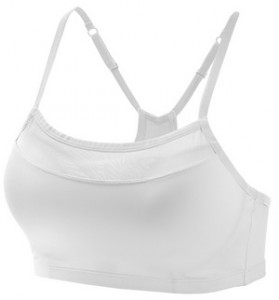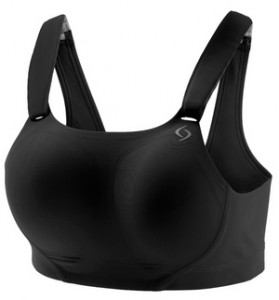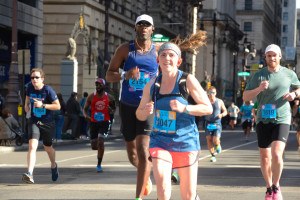Wearing the Wrong Sports Bra?
I recently moved to the Art Museum area and I couldn’t wait to hit Kelly Drive. On my first morning run, I dressed quickly and hustled down to my starting point. As I began my warm up, I was almost instantly distracted by the heaving bosom of a woman jogging in place beside me. She should really invest in a better sports bra, I thought to myself. I don’t normally spend my workouts scoping out the chests of my fellow exercisers, but I wear a 36D bra so, from one large-chested lady to another, I felt her pain.
A few minutes later, another female runner passed me and I noticed she had layered not one, not two, but three sports bras in order to restrain her bouncing breasts. On my left ,another woman’s chest was bouncing so furiously under her T-shirt that I worried she’d get black eyes if she quickened her pace. Is it that difficult to find a properly fitting sports bra? I wondered. Then I looked down at my own doubled-up boob bondage and realized I was just as guilty as these women. Although I’ve been wearing a sports bra for most of my life, I’ve never learned how to purchase one that fits me correctly. And, the more I looked into it, the more I realized that in addition to being unsightly and a little uncomfortable, wearing the wrong sports bra can also be dangerous.
According to a recent study in the Journal of Science and Sports Medicine, “Ill-fitting bras and insufficient breast support can lead to the development of musculoskeletal pain and inhibit women participating in physical activity.” Translation: Wearing a sports bra that doesn’t fit correctly can cause you a lot of pain and prevent you from getting the most physical benefit from your workout.
The same study found that 85 percent of the women interviewed were unable to choose the best bra for their body type, even after trying on several options.
To help myself and the rest of Philly’s women exercisers, I spoke with Kate Reese of Philadelphia Runner. Check out five simple tips for buying the right bra below.
Know the terminology.
There are two basic types of sports bras: compression bras and encapsulation bras.
The difference between the two is simple: Compression bras support the chest as a whole and encapsulation bras support each breast individually.
Compression bras are the standard, flat bras you can buy in Target or other non-sporting goods stores. These bras are effective for women with smaller chests, but will not provide enough support for larger-chested women.
Women with larger chests should wear encapsulation bras, which look more like traditional undergarments, with a cup for each breast.
These bras have a wide, adjustable band and thick, adjustable shoulder straps so that you can customize how much support you’re getting.
Some encapsulation bras also come with underwires or figure-eight wires. These are especially good for large-chested women who do high-impact activities like running.
Choose synthetic fabrics.
Though many cheaper bras are made from cotton, it’s worth it to invest in one that is made from synthetic materials. “Cotton is great, but it gets wet, it stays wet, and it tends to move around,” says Reese. Bras made from synthetic material are designed to wick moisture away from your body, which keeps you cooler and many have an antimicrobial component, which cuts down on the growth of bacteria.
Give it a test run. Literally.
In order to make sure your sports bra is supportive enough, Reese recommends doing a few quick exercises — jumping jacks, running in place, and wide arm circles — in the fitting room. “It feels a little foolish,” she says, “But that’s going to test the up-and-down movement, the side-to-side movement and everything in between.”
For women who participate in high-impact activity (like running or tennis), you want a very tight fit and little to no breast movement. For women who prefer lower impact exercise (like yoga), the bra does not need to be as tight, but should still hold the breasts in place. Keep in mind: While it’s nearly impossible to completely prevent movement, the less bounce you have, the less energy your body is wasting and the less likely you are to injure your back.
While you’re trying on the bra, also make sure there isn’t any skin popping out from the sides of the bra. If that happens, you probably need a larger cup size. The bra should be tight enough to hold your breasts in place during exercise, but not so tight that it restricts breathing, digs into your shoulders, or causes any pain.
Focus on comfort.
“It’s just like buying shoes. Buy the bra that you’re least aware of,” Reese says. What this means is simple: If you try a bra and something pokes you or just doesn’t feel right, don’t settle or tell yourself that you might break it in. The reality is that the irritation will likely become more intense once you begin exercising.
Be willing to spend some money.
Good sports bras are pricey. “If you’re small, you can get away with almost anything. You can get a cheap bra and it will probably hold you in place pretty well,” says Reese. She suggests that if you have small- to medium-sized breasts — up to a small C cup — you can probably find an adequate bra for $25 to $35.
However, as cup size rises, so does the price. “They start getting pretty pricey and that’s just because the technology involved is insane. There’s a ton going on in some of them. Some have a figure-8 wire for support,” Reese explains, noting that prices for most encapsulated bras made from synthetic material top out at around $60. “Unless they can tell you something really unique about it, I would guess that anything priced higher than that is marked up,” she says.
Keep in mind that a sports bra is a long-term investment. If you buy a good one, it should last at least a year, if not longer. For specialized guidance, visit your favorite specialty sporting goods store.





